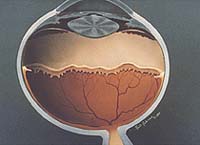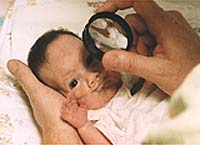Oxygen restrictions can be eased once ROP occurs
But premature infants without ROP should continue to follow restrictions.
WASHINGTON — Supplemental oxygen given to premature infants with moderate cases of retinopathy of prematurity (ROP) does not make the condition worse.
Clinicians do not have to be as restrictive as they have been when giving supplemental oxygen to infants who have already developed moderate ROP, according to research funded by the U.S. National Eye Institute (NEI) and reported in the February issue of Pediatrics.
“Up to now, there have been tight restrictions on the amount of oxygen low birthweight infants were permitted to have,” said NEI Director Carl Kupfer, MD. “This is because doctors have been concerned about a possible adverse effect of supplemental oxygen on the eyes of infants with ROP. While the benefits and risks of supplemental oxygen must be individually considered for each infant, doctors no longer need to worry that supplemental oxygen, as used in this study, will harm eyes with moderate ROP.”
Supplemental oxygen helps infants survive, but it might induce ROP. Supplemental oxygen might cause the disease to progress from a moderate stage, when surgery is not needed, to a severe stage, which usually requires surgery or sometimes permanently damages sight.
Primary investigator Dale Phelps, MD, said, “Neonatologists and pediatricians who take care of the babies have had to be very restrictive in the way they use oxygen. They had to be careful not to use too little and cause brain damage or use too much, which would hurt the eyes. Now we know that once the eye disease has already developed, you don’t have to worry nearly so much about using too much oxygen.”
Parameters defined
 ---Formation of an ROP ridge is seen in this artist’s conception of the interior of an infant’s eye.
---Formation of an ROP ridge is seen in this artist’s conception of the interior of an infant’s eye.
FIGURE COURTESY OF OREGON HEALTH SCIENCES UNIVERSITY.
ROP develops in about 14,000 to 16,000 infants each year who weigh less than 1,250 g at birth. In 80% of cases, the disease improves and leaves no permanent damage. However, about 1,100 to 1,500 infants annually develop ROP that is severe enough to require surgical treatment, according to the NEI.
Research suggested that controlled amounts of supplemental oxygen might stop ROP’s progression. If controlled amounts of supplemental oxygen could prevent progression, then infants could avoid possible long-term side effects.
The clinical trial, called the Supplemental Therapeutic Oxygen for Prethreshold ROP (STOP-ROP) study, initially enrolled 649 infants; 597 completed the study. The clinical trial was conducted at 30 study centers involving 71 hospitals across the United States.
“Of the infants in the study with moderate ROP who received the supplemental oxygen, 41% progressed to severe ROP,” Dr. Phelps said. She is chief of neonatology and a professor of pediatrics and ophthalmology at Children’s Hospital at Strong at the University of Rochester School of Medicine and Dentistry.
She added, “Of the infants with moderate ROP who did not receive the supplemental oxygen, 48% progressed to severe ROP. Statistically, there is no difference.”
Researchers reported in Pediatrics that they randomized premature infants with confirmed prethreshold ROP in at least one eye and median pulse oximetry of less than 94% saturation.
One group of 325 infants received a conventional oxygen therapy with pulse oximetry of 89% to 94% saturation. The second group of 324 patients received supplemental oxygen with pulse oximetry of 96% to 99% saturation.
Masked examiners gave weekly check-ups until each study eye reached an ophthalmic endpoint. Researchers defined adverse ophthalmic endpoints as reaching threshold criteria for laser or cryotherapy in at least one study eye. They also defined favorable ophthalmic endpoints as regression of the ROP into zone 3 for at least two consecutive weekly examinations or full retinal vascularization.
Unexpected finding
 ---A premature infant is given an eye examination to check for ROP.
---A premature infant is given an eye examination to check for ROP.
PHOTOGRAPH COURTESY OF CHILDREN'S HOSPITAL, BUFFALO, USA
Researchers recorded ophthalmic findings, pulmonary status, growth and interim illnesses at 3 months after each infant’s due date. They reported in Pediatrics that the rate of progression to threshold in at least one eye was 48% in the conventional arm and 41% in the supplemental arm.
After adjusting for baseline ROP severity, disease, race and gestation age, researchers learned the odds ratio for progression was 0.72.
Final structural status of all study eyes at 3 months of corrected age showed similar rates of severe sequelae in both treatment arms.
Retinal detachments or folds occurred in 4.4% of conventional oxygen patients and 4.1% of supplemental oxygen patients. Macular ectopia occurred in 3.9% of conventional oxygen patients and 3.9% of supplemental oxygen patients.
“We found something we did not expect,” Dr. Phelps said. “The infants in the study fell into two groups — those whose moderate ROP was complicated with dilated eye blood vessels and those whose blood vessels were not dilated. Modest supplemental oxygen significantly reduced the need for surgery in the second group.”
This finding needs to be confirmed with additional research before researchers can recommend modest supplemental oxygen as a treatment for infants with moderate ROP without dilated blood vessels, she said.
Adverse events
 ---Premature infant with ROP being examined by pediatric ophthalmologist.
---Premature infant with ROP being examined by pediatric ophthalmologist.
PHOTOGRAPH COURTESY OF PHOTOGRAPHY DEPARTMENT, CASEY EYE INSTITUTE, PORTLAND, USA
A subgroup analysis of plus disease, which researchers defined as dilated and tortuous vessels in at least two quadrants of the posterior pole, suggested that infants without plus disease responded more to supplemental therapy.
“There are subgroups of moderate ROP, a little worse and a little milder, and the milder kids made up two-thirds of the kids we enrolled. It was that group that showed a benefit,” Dr. Phelps told Ocular Surgery News.
Of the infants without plus disease, 46% treated with conventional oxygen got worse, compared with 32% of supplemental oxygen patients. Of patients with plus disease, 52% of conventional oxygen patients showed progression, compared with 57% of supplemental oxygen.
Pneumonia and exacerbated chronic lung disease occurred in 13.2% of infants who received supplemental oxygen, compared with 8.5% of infants in the conventional arm.
“Most of the neonatologists and ophthalmologists who have been involved in the study and have seen everything felt that the pulmonary side effects were not that serious,” Dr. Phelps said.
Also, researchers reported, at 50 weeks of postmenstrual age, that fewer conventional patients than supplemental patients remained hospitalized, on oxygen and on diuretics. However, growth and developmental milestones did not differ.
Easing concerns
Dr. Phelps said there were side effects in some infants who received the supplemental oxygen, including a temporary worsening of their chronic lung disease.
“In addition, we examined the infants 3 months after their due dates, when they were no longer on the treatment,” Dr. Phelps said. “We found, at the 3-month exam, that the children who received the supplemental oxygen were more likely than those who did not receive the extra oxygen to be either in the hospital on oxygen or on medications for chronic lung disease. However, these side effects themselves are not life threatening and are acceptable risks for infants who require extra oxygen for cardiopulmonary reasons.”
Researchers concluded in Pediatrics that use of supplemental oxygen at pulse oximetry saturation of 96% to 99% did not cause prethreshold ROP to get worse. However, it did not reduce the number of infants requiring peripheral ablative surgery.
The subgroup analysis suggested that supplemental oxygen benefited infants who have prethreshold ROP without plus disease, but this finding requires additional study, Dr. Phelps said.
Supplemental oxygen increased the risk of adverse pulmonary events, including pneumonia and exacerbation of chronic lung disease, as well as the need for oxygen, diuretics and hospitalization at 3 months of corrected age.
Researchers wrote in their conclusion that although the relative risks and benefits of supplemental oxygen for each infant must be individually considered, clinicians no longer need to be concerned that supplemental oxygen will exacerbate active prethreshold ROP.
For Your Information:
- Carl Kupfer, MD, is director of the National Eye Institute. He can be reached at 31 Center Drive, MSC 2510, Bldg. 31, Room 6A03, Bethesda, MD 20892 U.S.A.; +(1) 301-496-2234; fax: +(1) 301-496-9970.
- Dale Phelps, MD, is chief of the division of neonatology at Children’s Hospital at Strong at the University of Rochester School of Medicine and Dentistry. She can be reached at 601 Elmwood Ave., Box 651 – Pediatrics, Rochester, NY 14642 U.S.A.; +(1) 716-275-5884; fax: +(1) 716-461-3614.
- The STOP-ROP Multicenter Study Group. Supplemental therapeutic oxygen for prethreshold retinopathy of prematurity (STOP-ROP), a randomized, controlled trial. I: primary outcomes. Pediatrics. 2000;105(2):295-310.
